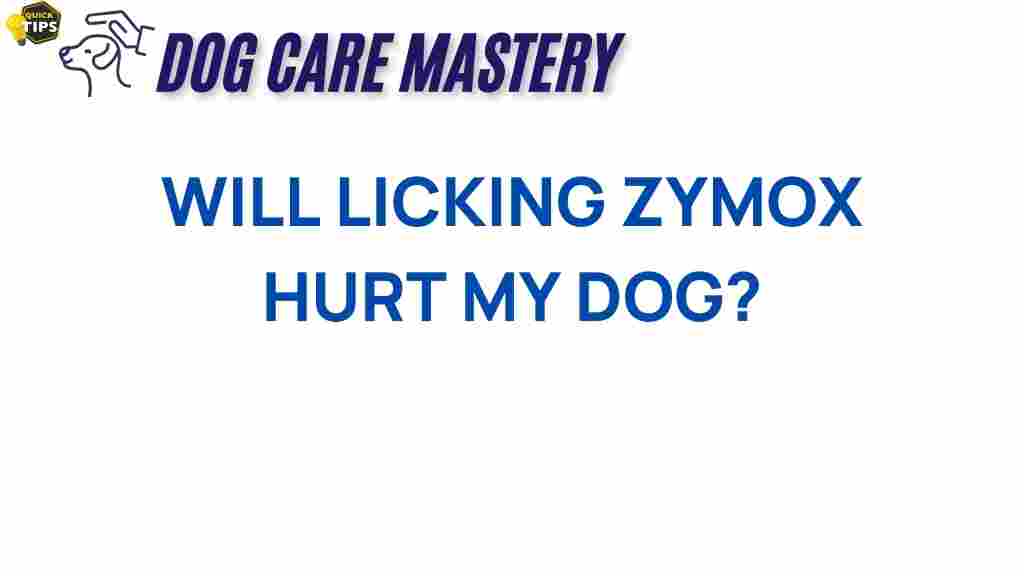The Hidden Dangers: Will Licking Zymox Hurt Your Dog?
When it comes to caring for our beloved dogs, we often find ourselves searching for solutions to common ailments such as skin irritations, ear infections, and other health issues. One product that has gained popularity among pet owners is Zymox. While it is marketed as a safe and effective treatment, many pet owners wonder: will licking Zymox hurt your dog? In this article, we will explore the potential risks associated with Zymox, how to use it properly, and what to do if your dog licks it.
What is Zymox?
Zymox is a brand of topical and oral products designed to help manage various pet health issues. It contains natural enzymes that are believed to assist in the healing process of wounds, skin irritations, and infections. Zymox is available in various forms, including creams, gels, and ear drops. Many pet owners have reported positive results, but it is essential to understand how to use these products safely.
How Does Zymox Work?
The active ingredients in Zymox are enzymes that target harmful bacteria and fungi while promoting healing. Here’s a brief overview of the active components:
- Lysozyme: An enzyme that breaks down bacterial cell walls.
- Lactoferrin: A protein that has antibacterial and antifungal properties.
- Protease: An enzyme that helps break down proteins, aiding in tissue healing.
These ingredients work synergistically to address infections and promote healing without the use of harsh chemicals. However, the question remains: what happens if your dog licks Zymox?
Understanding the Risks of Licking Zymox
While Zymox is generally considered safe for topical use, it’s important to recognize the risks associated with ingestion. If your dog licks the product, several factors can influence whether it will cause harm:
1. Ingredient Sensitivity
Some dogs may have sensitivities or allergies to specific ingredients in Zymox. If your dog licks the product, they may experience:
- Vomiting
- Diarrhea
- Skin irritations
2. Amount Ingested
The amount of Zymox your dog ingests can determine the severity of any potential reaction. A small lick may not cause noticeable effects, but larger quantities could lead to gastrointestinal upset. Always monitor your dog for any signs of discomfort.
3. Underlying Health Conditions
If your dog has pre-existing health conditions, such as gastrointestinal disorders or allergies, the risks of licking Zymox may increase. Consult your veterinarian if your dog has any underlying health issues before using Zymox.
4. Duration of Exposure
If your dog is constantly licking the area treated with Zymox, the risk of ingestion increases. This can lead to more severe reactions, so it’s crucial to apply the product strategically and prevent excessive licking.
How to Use Zymox Safely
To minimize the risks associated with Zymox, follow these guidelines:
1. Apply Sparingly
When applying Zymox, use the recommended amount for your dog’s size and condition. Applying too much can lead to excess licking and increased risk of ingestion.
2. Use an Elizabethan Collar
If your dog tends to lick at the treatment site, consider using an Elizabethan collar (cone) to prevent access. This is especially important during the initial healing period.
3. Monitor Your Dog
After applying Zymox, keep an eye on your dog for any signs of licking or discomfort. If you notice excessive licking, intervene promptly and redirect their attention.
4. Follow Instructions
Always follow the manufacturer’s instructions when using Zymox. This includes application frequency and dosage to ensure safe and effective use.
5. Consult Your Veterinarian
If you’re unsure about using Zymox or if your dog has specific health concerns, consult your veterinarian for personalized advice and recommendations.
Troubleshooting: What to Do If Your Dog Licks Zymox
If you discover that your dog has licked Zymox, here’s a step-by-step guide on what to do:
Step 1: Assess the Situation
Determine how much Zymox your dog has ingested. If it’s only a small amount, it may not cause harm, but you should still monitor for any reactions.
Step 2: Observe for Symptoms
Watch for signs of discomfort or adverse reactions, including:
- Vomiting
- Diarrhea
- Lethargy
- Excessive drooling
Step 3: Contact Your Veterinarian
If your dog exhibits any concerning symptoms or has ingested a large amount of Zymox, contact your veterinarian immediately. They can provide guidance on the next steps and determine if your dog needs to be seen.
Step 4: Provide Comfort
If your dog seems uncomfortable, ensure they have a quiet and comfortable resting place. Offer them water to help flush out their system, but avoid forcing them to drink if they are reluctant.
Step 5: Prevent Future Incidents
After the incident, take measures to prevent future licking. This may include using an Elizabethan collar, applying Zymox in a less accessible area, or choosing a different treatment method.
Conclusion: The Safe Use of Zymox
In summary, while Zymox can be an effective treatment for your dog’s health issues, it’s essential to be aware of the potential risks associated with licking the product. By understanding how Zymox works, using it safely, and knowing what to do if your dog licks it, you can help ensure your pet remains healthy and happy. Always consult with your veterinarian if you have any concerns or questions about your dog’s health and the use of Zymox.
For more information on pet health and safe grooming practices, check out our article on safe pet grooming techniques. It’s always better to be informed and prepared for any situation that may arise with your furry friend!
For further reading on Zymox and its effectiveness, you can visit this external resource.
This article is in the category Safety and created by dogcaremastery Team
